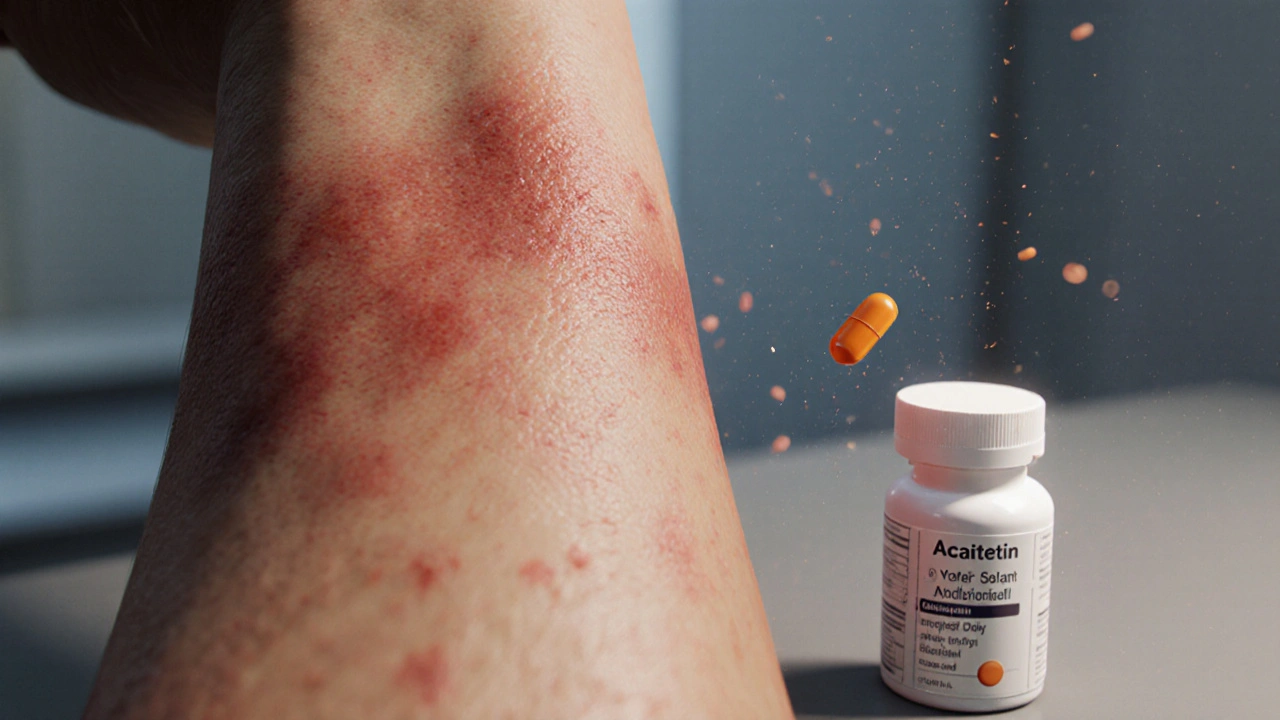Acitretin for Psoriasis: Benefits, Risks, and How It Stacks Up

Acitretin Dosing Calculator
Calculate your recommended acitretin dosage range based on your body weight. Always consult your healthcare provider before starting treatment.
Enter your weight to see your recommended acitretin dosage range.
Important Safety Note: Acitretin is highly teratogenic. Women of child-bearing potential must use two reliable forms of contraception for at least 3 years after stopping treatment. Always discuss these risks with your healthcare provider before starting acitretin.
Living with moderate‑to‑severe Psoriasis is a chronic autoimmune skin condition that produces thick, red, scaly patches can feel like a never‑ending battle. While topical creams and light therapy help many, a sizable group needs a systemic option to get the disease under control. That’s where acitretin steps in, but is it the right choice for you? This guide breaks down the real‑world pros and cons, dosing tricks, safety checks, and how the drug compares with other heavyweight treatments.
What Is Acitretin?
When doctors need a systemic option for stubborn plaque psoriasis, Acitretin is an oral retinoid that slows down skin cell turnover and reduces inflammation. First approved in the 1980s, it belongs to the same family as isotretinoin (the acne drug) but is formulated for longer‑term use in dermatology.
How Acitretin Works
Acitretin is a synthetic derivative of vitamin A. It binds to nuclear retinoic acid receptors in skin cells, which tells the cells to stop proliferating too quickly. The result is thinner plaques, less scaling, and a calmer immune response. Unlike biologics that target specific cytokines, Acitretin works at the genetic level, making it a broad‑spectrum option.
Top Benefits (The ‘Pros’)
- Effective for plaque and nail psoriasis. Clinical trials show a 50‑70% reduction in Psoriasis Area and Severity Index (PASI) scores after 12‑weeks of therapy.
- Oral administration - no injections or infusion appointments.
- Non‑immunosuppressive. It doesn’t raise infection risk the way methotrexate or biologics can.
- Low cost compared with biologic agents, especially in countries with public drug schemes.
- Can be combined with topical steroids for faster clearance of stubborn spots.
Key Drawbacks (The ‘Cons’)
- Liver toxicity. Elevations in ALT/AST occur in 5‑10% of patients; regular liver‑function tests are mandatory.
- Changes in lipid profile - triglycerides and LDL often rise, requiring fasting lipid panels.
- Teratogenicity. Acitretin remains in the body for up to 3 years after stopping; women of child‑bearing potential must use two reliable forms of contraception for at least 3 years.
- Dry skin, mucous membranes, and hair loss are common early side effects.
- Not suitable for patients with severe psoriasis‑related joint disease (psoriatic arthritis) because it doesn’t address inflammation in the joints.
Typical Dose Regimen & Monitoring
Doctors usually start at 0.25mg/kg per day (about 25mg for a 70‑kg adult) and may increase to a maximum of 1mg/kg if needed. The treatment course can be continuous or intermittent, depending on response and tolerance.
Because of the safety concerns, the following labs are checked:
- Baseline liver‑function tests (ALT, AST, bilirubin).
- Baseline fasting lipid profile.
- Pregnancy test for women of child‑bearing age before starting.
- Repeat liver and lipid panels every 4‑6weeks for the first 3months, then every 2‑3months thereafter.
Patients are also advised to use moisturizers and consider omega‑3 supplements to combat dryness and lipid spikes.
Acitretin vs. Other Systemic Options
| Feature | Acitretin | Methotrexate | Biologic (e.g., Adalimumab) |
|---|---|---|---|
| Route | Oral | Oral | Injection / Infusion |
| Onset of Action | 6‑12weeks | 4‑8weeks | 2‑4weeks |
| Cost (US$ per month) | ~$30‑$60 | ~$50‑$100 | ~$1500‑$2000 |
| Major Safety Concern | Teratogenicity, liver & lipids | Liver toxicity, bone marrow suppression | Infections, malignancy risk |
| Effect on Psoriatic Arthritis | Limited | Moderate | Strong |
Choosing the right drug hinges on a patient’s lifestyle, reproductive plans, comorbidities, and budget. Acitretin excels for those who want a cheap, oral, non‑immunosuppressive option and can adhere to strict contraception rules.
Who Should (and Shouldn’t) Use Acitretin
Ideal candidates are adults with moderate‑to‑severe plaque psoriasis who are not planning pregnancy for several years, have normal baseline liver function, and can tolerate routine blood work. It’s also a solid fallback for patients who develop antibodies against biologics.
Not recommended for:
- Pregnant women or those who cannot commit to long‑term contraception.
- Patients with pre‑existing liver disease, uncontrolled hyperlipidemia, or severe psoriasis‑related joint pain.
- Individuals who have struggled with severe dryness or mucosal cracking despite supportive care.

Practical Tips for Patients & Clinicians
- Start with a low dose; increase slowly while monitoring labs.
- Encourage daily moisturizer with ceramides; consider humidifiers in dry climates.
- Schedule lipid‑panel checks at the same time as liver tests to reduce clinic visits.
- Educate women of child‑bearing age about the 3‑year contraception rule-this often surprises patients.
- If lipid spikes appear, add a low‑dose statin under physician supervision.
Open communication about side‑effect expectations dramatically improves adherence and long‑term outcomes.
Bottom Line
Acitretin remains a valuable, cost‑effective tool in the dermatologist’s arsenal, especially for patients who want an oral pill without the immune‑suppressing baggage of methotrexate or biologics. Its biggest hurdles are liver monitoring, lipid management, and strict birth‑control requirements. By weighing these factors against personal health goals, patients can make an informed choice.
Frequently Asked Questions
How long does it take for Acitretin to improve psoriasis?
Most people notice a reduction in scaling and redness within 6‑12weeks, although maximal improvement can take up to 6months.
Can Acitretin be used during pregnancy?
No. Acitretin is highly teratogenic and stays in the body for up to three years after stopping. Women must use two reliable contraceptive methods for at least 3years post‑therapy.
What lab tests are required while on Acitretin?
Baseline and periodic liver‑function tests (ALT, AST), fasting lipid panel, and a pregnancy test for women of child‑bearing age are standard.
Is Acitretin safe for people with psoriasis on the scalp only?
If the disease is limited to the scalp, topical steroids or vitamin D analogues are usually sufficient. Acitretin is reserved for more extensive body involvement.
How does Acitretin compare cost‑wise to biologics?
Acitretin typically costs under $100 per month, while biologics can exceed $1500 per month, making the retinoid the budget‑friendly choice for many patients.

Karl Norton
October 16, 2025 AT 17:10Acitretin is just a cheap Band‑Aid for a messier disease.
Karen McCormack
October 30, 2025 AT 18:21When we contemplate the alchemy of skin, we are reminded that every molecule carries a narrative, a lineage of intent that stretches back to the primordial whispers of vitamin A.
Acitretin, a synthetic echo of that ancient vitamin, steps onto the stage not as a hero but as a stoic envoy, negotiating with keratinocytes and immune cells alike.
Its mechanism, a gentle coaxing of nuclear retinoic acid receptors, reflects a philosophy of moderation rather than domination, a principle that resonates with the very ethos of dermatologic stewardship.
Yet, this modesty is double‑edged; the drug’s broad‑spectrum reach can be both a blessing and a curse, smoothing plaques while unsettling lipid profiles.
One must also reckon with the temporal gravity of its teratogenic legacy-a lingering specter that can haunt the body for up to three years after cessation.
The cost, undeniably modest, invites a socioeconomic discourse: is affordability a virtue when weighed against the rigorous demands of contraception and laboratory surveillance?
From a clinical perspective, the drug’s efficacy, reflected in PASI reductions of 50‑70% over twelve weeks, provides a tangible hope for patients who balk at injections.
However, the absence of direct anti‑inflammatory action on joints makes it a sub‑optimal choice for those wrestling with psoriatic arthritis, a nuance often glossed over in patient brochures.
In practice, the necessity of regular liver function and lipid panels imposes a logistical burden that can erode adherence, especially in underserved settings.
Nevertheless, the oral route remains a seductive simplicity for patients averse to the invasiveness of biologics.
Strategically, clinicians might consider a low‑dose initiation, titrating cautiously while monitoring hepatic enzymes, to mitigate early toxicity.
Adjunctive measures-emollients, omega‑3 supplementation, and perhaps a low‑dose statin-can temper the side‑effect profile, turning potential pitfalls into manageable variables.
The psychosocial dimension cannot be ignored; the knowledge of a three‑year contraceptive requirement can be a source of anxiety, demanding sensitive counseling and shared decision‑making.
Thus, the decision matrix for acitretin is a mosaic of clinical efficacy, safety, cost, lifestyle compatibility, and reproductive planning.
When these pieces align, the drug shines as a cost‑effective, non‑immunosuppressive option; when they clash, it merely resurfaces as a historic footnote in the evolving saga of psoriasis therapy.
Earl Hutchins
November 13, 2025 AT 20:32Acitretin can be a solid choice for plaque‑type psoriasis when patients want an oral pill and can handle the monitoring schedule.
Tony Bayard
November 27, 2025 AT 22:43Exactly, and the drama of waiting six months for full effect can feel like a slow‑burn romance with your own skin.
But the payoff, when the plaques finally recede, is worth the patience and the extra labs.
Jay Crowley
December 12, 2025 AT 00:54Short‑term labs are a pain.